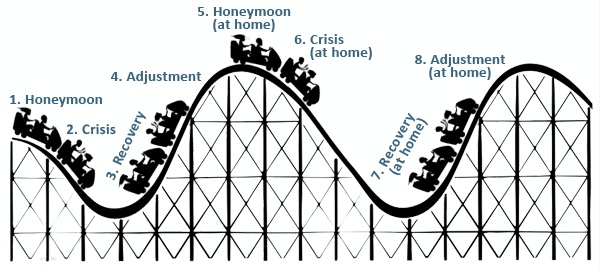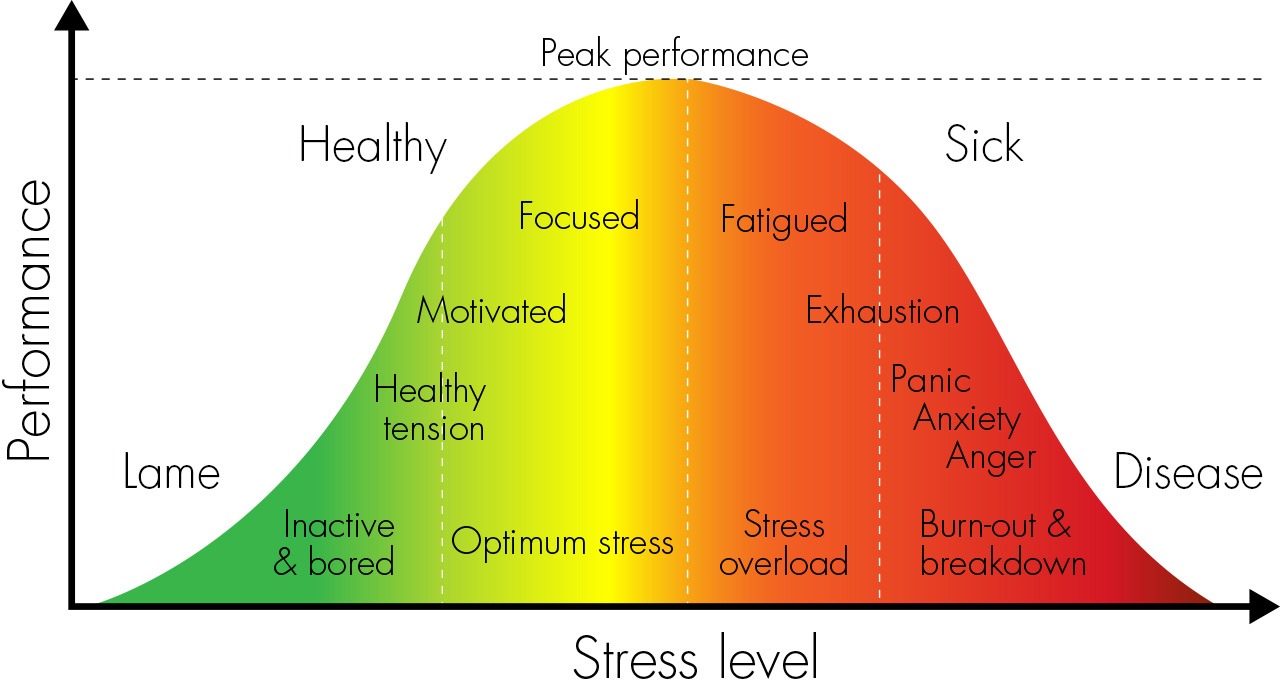Navigating Through University Life
Date: Wednesday, July 27, 2022
Navigating Through University Life

Coming back to university after a break or entering university for the first time can be both exciting and daunting.
We may face adjustment issues, even in environments which are not new to us. This could be coupled with academic challenges, an influx of new responsibilities, managing peer relationships, amidst other stressors.
How can we better prepare ourselves as we navigate the rigour of university life?
NUS Health & Wellbeing and University Counselling Services shares some tips below!

Source: Gullahorn & Gullahorn, 1963
This curve (Gullahorn & Gullahorn, 1963) shows an example of how an individual’s adjustment trajectory may look like. You may start off excited to meet new friends, to catch up with old ones, or discover what new modules may have in store for you. That being said, not everyone’s journey would begin on a positive note, and you might also have some mixed feelings or anxiety about diving into the rigour of university life.
Having some anxiety and a dip in mood is normal when going through a period of adjustment! It is paramount that we acknowledge these difficulties and be aware of the resources we can use to help us through this time.
Some steps you can take to better deal with adjustment difficulties are adopting a positive attitude and practising identifying your negative thoughts and feelings and finding ways to better manage them. Don’t forget to engage your support network as well! Reach out to friends and family when you feel overwhelmed.
Don’t be too hard on yourself. Finding your rhythm and adjustment takes time.
Look out for signs of fatigue and burnout and learn to keep your stress within a healthy range.
If you find yourself experiencing persistent anxiety and exhaustion, take a step back and listen to your body. Ask yourself what it is you need in that moment to help address this (e.g. delegation, lowered expectations, more self-care).

Source: Yerkes, R. M., & Dodson, J. D., 1908
View each setback as a challenge rather than a threat to self-worth, confidence or purpose. Know that you are more than the bullet points on your résumé and your academic grades.
When conveying our personal boundaries and expectations, keep in mind to always practise two-way communication. Remember, mutual respect and understanding is the foundation to collaboration and teamwork.
Contributed by NUS Health & Wellbeing and University Counselling Services
References:
• American Psychiatric Association. (2013). Diagnostic and statistical manual of mental disorders (5th ed.). https://doi.org/10.1176/appi.books.9780890425596
• Gullahorn, J. T., & Gullahorn, J. E. (1963). An extension of the U-curve hypothesis. Journal of Social Issues, 19(3), 33–47. https://doi.org/10.1111/j.1540-4560.1963.tb00447.x
• Yerkes, R. M., & Dodson, J. D. (1908). The relation of strength of stimulus to rapidity of habit-formation. Journal of Comparative Neurology and Psychology, 18(5), 459–482.
Photo credit:
• https://www.freepik.com/photos/college-campus
College campus photo created by tirachardz - www.freepik.com

Coming back to university after a break or entering university for the first time can be both exciting and daunting.
We may face adjustment issues, even in environments which are not new to us. This could be coupled with academic challenges, an influx of new responsibilities, managing peer relationships, amidst other stressors.
How can we better prepare ourselves as we navigate the rigour of university life?
NUS Health & Wellbeing and University Counselling Services shares some tips below!
Adjusting back to school life
It is normal to experience ups and downs when we first return to school. Adjusting to an environment, even one you have been in before, might be stressful and disorienting. What was once familiar to us may seem unfamiliar when we have not interacted with an environment for a while. Adjustment issues may arise when a new stressor leads to maladaptive reactions such as low mood and impaired social functioning (American Psychiatric Association, 2013).
Source: Gullahorn & Gullahorn, 1963
This curve (Gullahorn & Gullahorn, 1963) shows an example of how an individual’s adjustment trajectory may look like. You may start off excited to meet new friends, to catch up with old ones, or discover what new modules may have in store for you. That being said, not everyone’s journey would begin on a positive note, and you might also have some mixed feelings or anxiety about diving into the rigour of university life.
Having some anxiety and a dip in mood is normal when going through a period of adjustment! It is paramount that we acknowledge these difficulties and be aware of the resources we can use to help us through this time.
Some steps you can take to better deal with adjustment difficulties are adopting a positive attitude and practising identifying your negative thoughts and feelings and finding ways to better manage them. Don’t forget to engage your support network as well! Reach out to friends and family when you feel overwhelmed.
Don’t be too hard on yourself. Finding your rhythm and adjustment takes time.
Balancing obligations and responsibilities
The beginning of a new school term often means an influx of obligations and responsibilities. It also means making intentional decisions on how you spend your time and energy becomes all the more important. Learn to say “no” to work that is beyond your capacity or misaligned with your interests and goals.Understanding our stress limits
It is easy to fall into a mindset that pushing ourselves as hard as we can, 24/7, is the route to success. However, did you know that peak performance usually occurs when we are exposed to moderate amounts of stress? Whilst stepping out of your comfort zone can help you to learn and grow, keep in mind not to overstrain yourself.Look out for signs of fatigue and burnout and learn to keep your stress within a healthy range.
If you find yourself experiencing persistent anxiety and exhaustion, take a step back and listen to your body. Ask yourself what it is you need in that moment to help address this (e.g. delegation, lowered expectations, more self-care).

Source: Yerkes, R. M., & Dodson, J. D., 1908
Manoeuvring academic challenges
When we encounter academic challenges, the key is in being able to bounce back. Academic buoyancy is the ability to fail well, fail forward, and bounce back from the inevitable challenges experienced in school. Ask yourself, what went wrong? What can you learn from this? How can we improve so that we prevent this from happening again in the future?View each setback as a challenge rather than a threat to self-worth, confidence or purpose. Know that you are more than the bullet points on your résumé and your academic grades.
Managing peer relationships
As we begin our work and studies, working with people will come with itself a range of perks and challenges. Remember that conflicts are bound to happen as people come together with their different backgrounds, experiences, and perspectives. Acknowledge each other’s differences and seek for commonalities and strengths in others and yourself. Also, be patient and empathetic when working out the differences.When conveying our personal boundaries and expectations, keep in mind to always practise two-way communication. Remember, mutual respect and understanding is the foundation to collaboration and teamwork.
Contributed by NUS Health & Wellbeing and University Counselling Services
References:
• American Psychiatric Association. (2013). Diagnostic and statistical manual of mental disorders (5th ed.). https://doi.org/10.1176/appi.books.9780890425596
• Gullahorn, J. T., & Gullahorn, J. E. (1963). An extension of the U-curve hypothesis. Journal of Social Issues, 19(3), 33–47. https://doi.org/10.1111/j.1540-4560.1963.tb00447.x
• Yerkes, R. M., & Dodson, J. D. (1908). The relation of strength of stimulus to rapidity of habit-formation. Journal of Comparative Neurology and Psychology, 18(5), 459–482.
Photo credit:
• https://www.freepik.com/photos/college-campus
College campus photo created by tirachardz - www.freepik.com